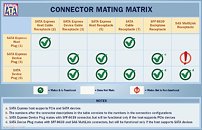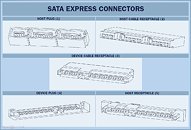Tuesday, April 16th 2013

Intel 9-series Chipset Could Feature SATA Express Interface
Intel may be a couple of months away from launching its Core "Haswell" processor family, and the 8-series "Lynx Point" family of chipset to back it, but is already talking to partners about the platform's successor, slated for the second quarter of 2014. Core "Haswell" introduces the industry to socket LGA1150 motherboards, and Core "Broadwell" could, in all likelihood, provide continuity to it, much in the same way "Ivy Bridge" did to "Sandy Bridge." Intel could introduce a new chipset to tag along with "Broadwell."
According to a roadmap slide seen by VR-Zone, Intel's 9-series chipset will include at least two models, the Z97 targeting enthusiasts, and the H97 targeting mainstream consumers. These chipset could drive socket LGA1150 motherboards going into the second half of 2014, and could support both "Haswell" and "Broadwell," in the same way today's 7-series chipset support "Sandy Bridge" and "Ivy Bridge." Intel could introduce a major feature with 9-series, SATA Express.We already know that Intel's upcoming 8-series chipset sees the chipset feature SATA Rev. 3.0 (6 Gb/s) on all six of its ports. Today's 7-series chipset feature a combination of two SATA 6 Gb/s, and four SATA 3 Gb/s. Tomorrow's 9-series could introduce SATA Express, although there's no information on just how many ports will support it. SATA Express is being drafted by SATA-IO into what could be SATA revision 3.2. It is essentially SATA link-layer over PCIe physical layer, although it manages to retain backwards compatibility with older SATA standards (at reduced performance, of course). SATA Express could provide drives with 1000 MB/s of bandwidth per direction.
Source:
VR-Zone Chinese
According to a roadmap slide seen by VR-Zone, Intel's 9-series chipset will include at least two models, the Z97 targeting enthusiasts, and the H97 targeting mainstream consumers. These chipset could drive socket LGA1150 motherboards going into the second half of 2014, and could support both "Haswell" and "Broadwell," in the same way today's 7-series chipset support "Sandy Bridge" and "Ivy Bridge." Intel could introduce a major feature with 9-series, SATA Express.We already know that Intel's upcoming 8-series chipset sees the chipset feature SATA Rev. 3.0 (6 Gb/s) on all six of its ports. Today's 7-series chipset feature a combination of two SATA 6 Gb/s, and four SATA 3 Gb/s. Tomorrow's 9-series could introduce SATA Express, although there's no information on just how many ports will support it. SATA Express is being drafted by SATA-IO into what could be SATA revision 3.2. It is essentially SATA link-layer over PCIe physical layer, although it manages to retain backwards compatibility with older SATA standards (at reduced performance, of course). SATA Express could provide drives with 1000 MB/s of bandwidth per direction.



22 Comments on Intel 9-series Chipset Could Feature SATA Express Interface
Why at reduced performance? Isn't it, in this case, just a SATA controller connected via PCI-E?
That's precisely the bottleneck that needs the most work. CPU - RAM - SSD relative speeds are analogous to FLYING-DRIVING-WALKING; you spend most of your time waiting for the SSD to catch up, or if using HDD, the analogy would be to CRAWLING on your belly. In 2013, CPU and RAM speeds are already so fast, only benchmarks can tell the difference. So the only upgrade that will be noticeable "in the seat of your pants" would be to the SATA interface and subsequent drive improvements. Too bad we have to wait at least another year+, while CPUs and RAM will get faster for no reason we can use now.
For those of us on Ivy, that's yet another reason to sit tight through Haswell and wait for better things.
Also, current SSDs come nowhere near saturating SATA3 on small, random reads and writes.
Solid State vs Hard Disk
Despite decades of design improvements, the hard disk drive (HDD) is still the slowest component of any personal computer system. Consider that modern desktop processors have a 1 ns response time (nanosecond = one billionth of one second), while system memory responds between 30-90 ns. Traditional hard drive technology utilizes magnetic spinning media, and even the fastest spinning mechanical storage products still exhibit a 9,000,000 ns / 9 ms initial response time (millisecond = one thousandth of one second). In more relevant terms, the processor receives the command and must then wait for system memory to fetch related data from the storage drive. This is why any computer system is only as fast as the slowest component in the data chain; usually the hard drive.
In a perfect world all of the components operate at the same speed. Until that day comes, the real-world goal for achieving optimal performance is for system memory to operate as quickly as the central processor and then for the storage drive to operate as fast as memory. With present-day technology this is an impossible task, so enthusiasts try to close the speed gaps between components as much as possible. Although system memory is up to 90x (9000%) slower than most processors, consider then that the hard drive is an added 1000x (100,000%) slower than that same memory. Essentially, these three components are as different in speed as walking is to driving and flying.
Solid State Drive technology bridges the largest gap in these response times. The difference a SSD makes to operational response times and program speeds is dramatic, and takes the storage drive from a slow 'walking' speed to a much faster 'driving' speed. Solid State Drive technology improves initial response times by more than 450x (45,000%) for applications and Operating System software, when compared to their mechanical HDD counterparts. The biggest mistake PC hardware enthusiasts make with regard to SSD technology is grading them based on bandwidth speed. File transfer speeds are important, but only so long as the operational I/O performance can sustain that bandwidth under load.
Bandwidth Speed vs Operational Performance
As we've explained in our SSD Benchmark Tests: SATA IDE vs AHCI Mode guide, Solid State Drive performance revolves around two dynamics: bandwidth speed (MB/s) and operational performance I/O per second (IOPS). These two metrics work together, but one is more important than the other. Consider this analogy: bandwidth determines how much cargo a ship can transport in one voyage, and operational IOPS performance is how fast the ship moves. By understanding this and applying it to SSD storage, there is a clear importance set on each variable depending on the task at hand.
For casual users, especially those with laptop or desktop computers that have been upgraded to use an SSD, the naturally quick response time is enough to automatically improve the user experience. Bandwidth speed is important, but only to the extent that operational performance meets the minimum needs of the system. If an SSD has a very high bandwidth speed but a low operational performance, it will take longer to load applications and boot the computer into Windows than if the SSD offered a higher IOPS performance.
benchmarkreviews.com/index.php?option=com_content&task=view&id=1070&Itemid=60
Thanks?! :)
It's just the memory hierarchy and SSDs got put somewhere between DRAM and HDDs. The closer you move it to the CPU, the faster it will be. It will also cost more to produce for any given size. So hard drives exist to store a lot of data, not to be fast. That's what they're good at, like how RAM is good at holding active applications and how cache is good at holding recently used data.